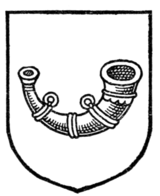A curious instrument now known nearly exclusively in connection with its use by farriers, and termed a Fleam (Fig. 535), occurs on the chief of the shield of Moore. A fleam, however, is the ancient form and name of a surgeon's lancet, and some connection with surgery may be presumed when it occurs. It is one of the charges in the arms recently granted to Sir Frederick Treves, Bart.
Furison.—This singular charge occurs in the shield of Black, and also in that of Steel. Furisons were apparently the instruments by which fire was struck from flint stones.
 Fig. 536.—Clarion. |
 Fig. 537.—Bugle-horn. |
 Fig. 538.—Bugle-horn stringed. |
Charges in connection with music and musical instruments do not occur very frequently, though the heraldic use of the Clarion (Fig. 536) and the Harp may perhaps be mentioned. The bugle-horn (Fig. 537) also occurs "stringed" (Fig. 538), and when the bands round it are of a different colour it is termed "veruled" or "virolled" of that colour.
The Human Heart, which should perhaps have been more correctly referred to in an earlier chapter, is a charge which is well known in heraldry, both English and foreign. Perhaps the best known examples of the heart ensigned with a crown is seen in the shields of Douglas and Johnstone. The legend which accounts for the appearance of this charge in the arms of Douglas is too well known to need repetition.
Ingots of silver occur in the shield of the borough of St. Helens, whilst the family of Woollan go one better by bearing ingots of gold.
A Maunch (Fig. 539), which is a well-known heraldic term for the sleeve, is, as it is drawn, scarcely recognisable as such. Nevertheless its evolution can be clearly traced. The maunch—which, of course, as a heraldic charge, originated in the knightly "favour" of a lady's sleeve—was borne from the earliest periods in different tinctures by the three historic families of Conyers, Hastings, and Wharton. Other garments have been used as heraldic charges; gloves in the arms of
